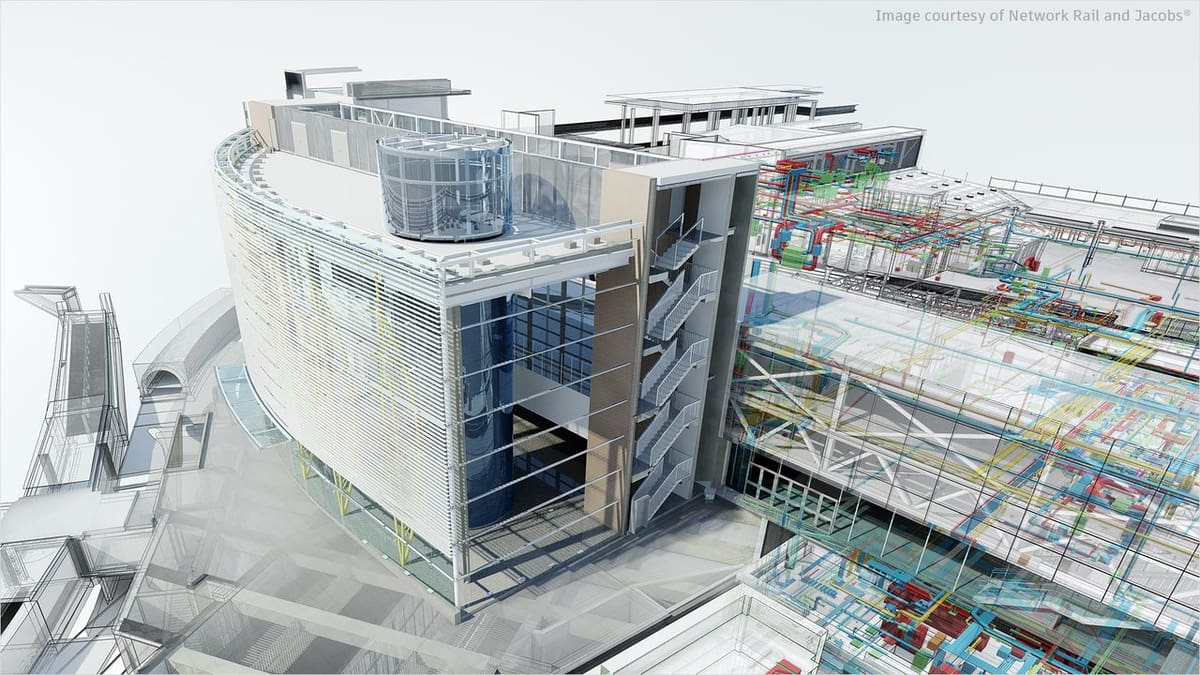What Is It?

The simple sketches and physical models that have been the tools of architects and engineers for millennia are giving way to richly detailed digital models defining every aspect of design, construction, and ultimately of use. Building information modeling (BIM) has emerged as a powerful tool to enable this new way of working and is set to evolve and grow even further.
BIM is a multi-faceted approach that allows teams of architects, engineers, and contractors (AEC) to work collaboratively. At its core is a comprehensive, 3D model of a real building or facility stored on shared files or a database. Using BIM software, multiple disciplines such as HVAC, electrical, plumbing, landscape, civil, interior design, and more can integrate and cross-check their designs. Project managers, cost engineers, fabricators, builders, and building maintenance teams can all use the same BIM model, reducing rework, improving quality, and ultimately reducing costs.
The potential benefits are so impressive that the use of BIM is increasingly mandated for both public- and private-sector projects. Overall reduction in construction costs is frequently cited as 15-20%, with lifetime cost savings as high as 30%.
Of course, realizing such benefits doesn’t happen overnight. BIM can be complex to implement and requires significant changes to work processes, new skills, and investment in software and other digital infrastructure. However, uptake is growing fast and BIM is evolving into a sophisticated solution that touches on every aspect of the lifecycle of new physical assets. Over 75% of major construction firms and architects use BIM, while adoption with smaller firms and contractors is half of this.
An Idea Whose Time Has Come

Although regarded as new, BIM traces its roots to as far back as 1975. Charles Eastman, then professor of Architecture at Carnegie Mellon University in the US, published an article in the AIA Journal in which he envisaged a computer database, referenced to a 3D model, of all the information associated with an asset, including CAD drawings, costs, materials, schedules, and so on.
Eastman had imagined the world of BIM, a concept way ahead of its time and also way ahead of the abilities of the simple and expensive computers of the day. The simpler concept of computer-aided design (CAD) was also born in the 1970s and was easier to implement. This proved to be cost-effective for architects and engineers as a tool to reduce the drudgery and time taken for 2D pen-and-paper drawings.
In the intervening period, CAD has become ubiquitous, and it was not until developments in the internet and the power of PCs that the more complex ideas of BIM could be implemented.
Today, BIM underpins the digitization of AEC disciplines, in particular for larger and more complex projects. BIM removes the cumbersome production and transfer of standalone (often paper-based) files and documents, allows remote teams to work in real-time to resolve design issues or process change requests, and increasingly enables detailed 3D visualization of complete projects and how they are constructed.
How It Works

BIM is a marriage of software and process and neither can exist effectively without the other.
Software
Software supports the capture of rich 3D BIM models and a wealth of additional information, collaboratively created by multiple disciplines. Not surprisingly, there s no “one-size-fits-all” solution, but a range of software exists to meet different needs. Vendors of BIM software include big players such as Autodesk, Aviva, Bentley, Hexagon, Trimble, and Dassault, as well as many smaller players. Most of these have emerged from providing more basic CAD offerings.
However, unlike classic CAD, BIM software is more data-intensive. For example, a circle on the roof of a CAD drawing may be annotated as a light fitting, but in BIM it would be identified explicitly as a light fitting along with other data that describes it. This extra data might help model the pattern of light it casts, document its power requirements and how it’s controlled, as well as include pointers to supply chain, installation, and maintenance information.
BIM Processes
The example above may seem trivial, but when the principle of associating additional data is extended to all aspects of a building’s design, it becomes enormously powerful. It allows cross-disciplinary teams to immediately check that their designs fit together and meet requirements, to quickly derive cost and construction schedules, simulate occupancy, and more.
Processes can be put in place, for example, to ensure that separate designs for HVAC, electrical, and plumbing fit together without clashes, or to quickly iterate design options to find the optimum solutions considering cost, timescale and, environmental considerations. The entire construction process (including landscaping and interior finish) can even be simulated and walked through to eliminate bottlenecks.
Processes such as these have the potential to be game-changing, but realizing benefits requires a mindset shift and new ways of working. Put simply, it’s about moving from producing deliverables in silos to working together, in near real-time, with contributors across all architectural, engineering, and construction disciplines.
Of course, to make all this happen, there have to be shared ground rules, standards, and common language or terminology. Thankfully all of these are in place already and provide a template to put BIM effectively into action.
Adapting to BIM

Learning the skills to use new BIM software is seldom a significant issue, especially for those with prior experience in CAD or other specialized AEC software. However, learning and understanding the significance of a new way of working requires a little more effort.
New Terminology and Skills
Agreed standards define everything from how data is exchanged between BIM software to the format of standard documents used to define the BIM process. Entire glossaries exist to define these, and although many terms may seem strange initially, few are complex and shouldn’t be intimidating. For example, the document describing who builds which part of a BIM model is known as the “BIM Execution Plan” (BEP), and details of exactly what information must be captured are contained in an “Exchange/Employer Information Requirements” (EIR) document.
Other de-facto terminology has also been broadly adopted to extend the dimensions of BIM’s relevance beyond 3D. The fourth dimension (4D) is time and scheduling, 5D is cost and quantity take-off, 6D relates to sustainability, and 7D typically describes post-construction data.
In the world of BIM, there are few existing construction roles that do not have something new to learn and, unsurprisingly, new and specialized roles have emerged, too.
Changing and New Jobs
The most prominent new role is that of the “BIM manager” who acts as a coordinating catalyst, facilitating cross-team collaboration and ensuring the quality of information captured in the evolving BIM model. For larger projects and organizations, this is a full-time position.
BIM technician, BIM engineer, and BIM architect are other specialized positions that can be found on larger initiatives. Although exact job descriptions may vary, these are typically roles that involve an in-depth understanding of the underlying software or the simulations and modeling they support.
Common existing roles are also changing. Site managers, for example, are increasingly expected to be BIM savvy – needing to understand BIM-generated work programs and also the importance of proactively adding site data, including commissioning data and as-built variances, to the BIM model.
Expanding its Reach
BIM hasn’t quite touched every AEC player for various reasons, but this is changing fast. The adoption of BIM by small- and medium-sized enterprises (SMEs) has been notably lower. Smaller companies tend to have employees that multitask, producing fewer opportunities to benefit from improving collaboration. They also often have lower customer demands for operations information and can find the upfront investment in software and training a deterrent.
This is changing rapidly as software with functionality and tools dedicated to SME needs gets cheaper. Additionally, industry experience is easier to access and training quality is both better and available for a lower cost.
Disciplines such as landscape architecture have tended to use different toolsets, like geographic information systems (GIS) instead of CAD, and work more standalone. This too is now changing, as tools begin to interface and incorporate BIM standards, allowing this discipline to become a more integral part of the project and expose time- and cost-efficiency opportunities. The same is also the case for interior design and final fitting specialists.
Challenges and Downsides
Despite all the positives, BIM is not a panacea. It can still be badly implemented or used inappropriately, and there can be potential downsides, too.
The old adage of “garbage in, garbage out” applies, and in the case of BIM, where there are so many potential downstream users, this can (and does) cause issues.
No matter how good a “virtual” BIM model is, the physical realities, especially on a construction site, are often different. BIM does not negate the need for common sense and hard-won project experience.
From a contractual, intellectual property, and legal standpoint, BIM can raise interesting questions in terms of ownership of data and sign-off of deliverables, too – although this is usually more than offset by reduced wrangling over change requests and design disputes.
A Maturing Concept

As an organization’s experience grows, its level of BIM maturity can be mapped against an internationally agreed model. Level 1 indicates the simple use of 3D modeling and is known as “Isolated BIM”. Level 2, “Collaborative BIM”, requires these models to be developed collaboratively and shared effectively. Level 3, “Integrated BIM”, is still being defined but includes more sophisticated data sharing and the inclusion of additional disciplines (e.g. geotechnics or facilities management).
One can already see these levels aiding BIM’s adoption. For example, compliance with level 2 was mandated by the UK Government in 2015 for large public projects, and many other countries have now done the same.
Beneath each BIM level are multiple tiers of requirements that are standardized in an agreed International Standard: ISO19650. This provides common terminology and a description of key process steps and deliverables.
Importantly, the standards also define how information can be exchanged between the BIM world and the non-BIM world. Data from sources that do not use BIM (e.g. equipment manufacturers) can be translated into formats BIM software can understand, and conversely, BIM systems can provide outputs that can be understood by others (e.g. auditors). As experience grows, we can already see how BIM is acting as a catalyst for the digitization of the entire construction value chain – and the pace of change is accelerating.
An Exciting Future

As most of today’s AEC operations move towards or consolidate around level 2 BIM, many are ready to level up! Where there’s a clear case to realize benefits, large and advanced firms are not waiting for a level 3 mandate – they are already making it happen.
Examples range from large projects adopting shared databases in the cloud to fabricators banning the use of separate cost spreadsheets (a notorious source of errors) and instead building that functionality into shared toolsets.
BIM’s comprehensive 3D models also make the use of virtual and augmented reality much easier for walkthroughs of proposed designs and for the sign-off and commissioning of individual models. There are also practical implementations of 3D construction progress being automatically captured by drone and activity tracked against the plan.
The application of artificial intelligence (AI) is also made easier with a foundation of BIM data and is already being used to generate significant parts of designs. And on a grand scale, the connection of multiple BIM models to help simulate and visualize “smart city” developments of the future is already possible.
In short, BIM is underpinning the digitization of the entire end-to-end construction process and playing a key role in realizing the future of our built environments.
Lead image source: B2BPurchase
License: The text of "BIM (Modeling): Simply Explained" by All3DP is licensed under a Creative Commons Attribution 4.0 International License.



